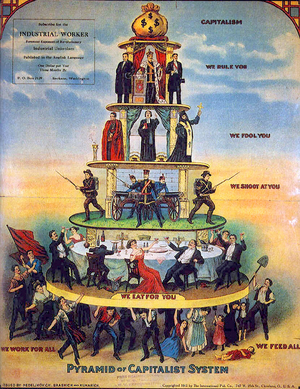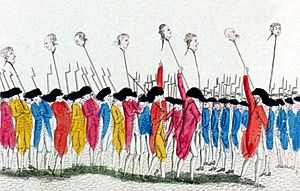Class conflict facts for kids
Class conflict is a term used to describe disagreements and tensions between different groups of people in a society. These groups, called social classes, often have different amounts of wealth, power, and resources. So, class conflict is basically the struggle between the "haves" (the rich) and the "have-nots" (the poor).
This idea is very important in the political and economic ideas of thinkers like Karl Marx. He believed that class struggle was a main way for big changes to happen in society. It was also a way for the majority of people, especially the working class, to gain more power.
Class conflict can show up in many ways. Sometimes it's direct, like when people fight over natural resources or land. It can also be indirect, like when people suffer from poverty or unsafe working conditions. Economic pressure, like the threat of losing a job, is another form. Even political writings can be a part of this conflict.
Sometimes, class conflict happens through legal actions, like when groups try to influence laws. It can also be direct, like a disagreement between workers and their bosses. For example, a company might lock out its employees to weaken their trade union. Or, workers might slow down their work to protest low wages or bad conditions.
Contents
What is Class Conflict?
In political science, especially for socialists and Marxists, "class conflict" describes how different social groups relate to the things that produce wealth. These include factories, farms, and machines. The control over how goods and services are made and who does the work is a big part of this struggle.
An anarchist named Mikhail Bakunin believed that the struggles of workers and farmers were key. He thought these struggles could lead to a social revolution. This revolution would remove the ruling class and create a society with more freedom for everyone.
Marx's theory of history suggests that class conflict is a major force in how economic systems change. This is true for systems like capitalism and feudalism, which have different social classes. Marxists often call the open fights "class war." They believe that the working class will eventually win this struggle under plutocratic capitalism.
Rich vs. Common People
Societies have always had different groups based on wealth or power. So, class structures have existed since ancient times. For example, in ancient Rome, there was often conflict between the rich and the common people.
Ancient Rome: Patricians vs. Plebeians
It was hard for the Romans to keep peace between the upper class, called the patricians, and the lower class, called the plebs. A French philosopher named Montesquieu noted that this conflict grew stronger after the Roman kings were overthrown.
In his book The Spirit of Laws, he listed four main complaints from the plebs:
- The patricians had too much easy access to public jobs.
- The rules gave the consuls too much power.
- The plebs felt constantly disrespected.
- The plebs had too little power in their meetings.
These issues were slowly fixed in the years after King Tarquin was removed from power.
Bosses vs. Workers
Before capitalism, thinkers like Jean-Jacques Rousseau and Adam Smith wrote about class struggle. Later, during the early industrial age, John Stuart Mill and Georg Wilhelm Friedrich Hegel also shared their thoughts. They discussed the conflict between employers and employees.
Class Conflict in Capitalist Societies
In capitalism, class conflict usually happens between the bourgeoisie (the owners) and the proletariat (the workers). This conflict is about things like:
- How many hours people work.
- How much wages are worth.
- How profits are shared.
- The cost of goods for consumers.
- The culture and rules at work.
- Who controls the government.
- How much economic inequality there is.
Even government programs that seem purely helpful, like disaster relief, can sometimes be part of this class conflict.
Socialism
Socialism is a political and economic idea. It suggests that the community or the state should own and control the means of production. This is instead of private individuals or companies. The goal is often to reduce class conflict and inequality.
Libertarianism
Some thinkers, like Charles Comte, argued that class struggle comes from groups that take control of the government. They believed the ruling class uses the government's power to benefit themselves. The "ruled" are then taxed and regulated for the benefit of the ruling classes.
They thought that through taxation, special laws, and privileges, the government creates class conflict. This happens by giving some groups advantages over others by force. In a free market, they argued, exchanges happen by choice and cooperation, which benefits everyone.
Class Conflict and Race
Some older Marxist ideas suggested that issues like racism or sexism were distractions from the main class struggle. They thought these divisions stopped people from working together for their common class interests. However, many modern thinkers believe that sex, race and class are all connected. There's an ongoing discussion about this in academic studies.
W. E. B. Du Bois thought that race, class, and nation were all linked. He believed they shaped how African Americans gained access to status, wealth, and power.
In recent times, some groups argue that the struggle based on race is less important. They believe the main struggle is about class, because workers of all races face similar problems and unfairness.
History of Class Conflicts
Here are some examples of class conflicts throughout history:
Ancient Times
- Gracchi Tribuneship in Rome.
- Social War in Rome (91–88 BC).
- Roman Servile Wars, which were slave rebellions.
- Yellow Turban Rebellion in China (184–205 AD).
Middle Ages
- Ciompi revolt in Florence, Italy (1378).
- Peasants' Revolt in England (1381).
- Jacquerie in 14th-century France.
Modern Era
- German Peasants' War (since 1524).
- English Civil War (1642–1651), which included groups like the Diggers.
- French Revolution (since 1789).
- Canut revolts in Lyon, France (since 1831), often seen as the start of the modern labor movement.
- Revolutions of 1848 in France and other places.
- Paris Commune (1871).
- Coal Wars in the US (1890–1930).
- 1905 Russian Revolution.
- Mexican Revolution (1910-1920).
- October Revolution in Russia (1917).
- Seattle General Strike of 1919.
- Spanish Civil War (1936–1939).
- Land Reform Movement (China) (1947–1950).
- Cuban Revolution (1953–1959).
- Hungarian Revolution of 1956, where workers formed councils.
- May 1968 in France.
- Several strikes by coal miners in the United Kingdom:
- Occupy Wall Street (2011).
- Yellow vests movement in France (2018–present).
- 2019–2020 Chilean protests.
- 2019-2020 Hong Kong protests.
See also
 In Spanish: Lucha de clases para niños
In Spanish: Lucha de clases para niños
- Classism
- Economic stratification
- No War But The Class War
- Occupy movement
- Slave rebellion
- Industrial Workers of the World






